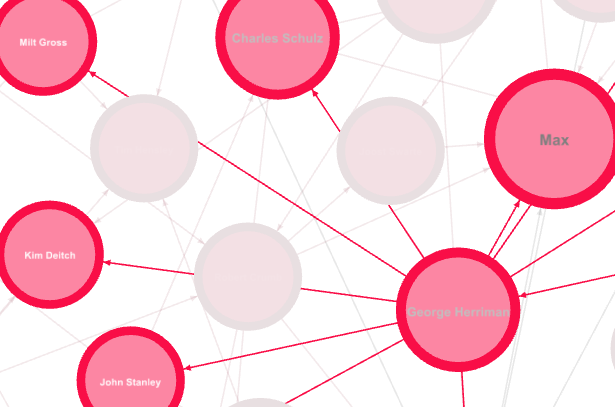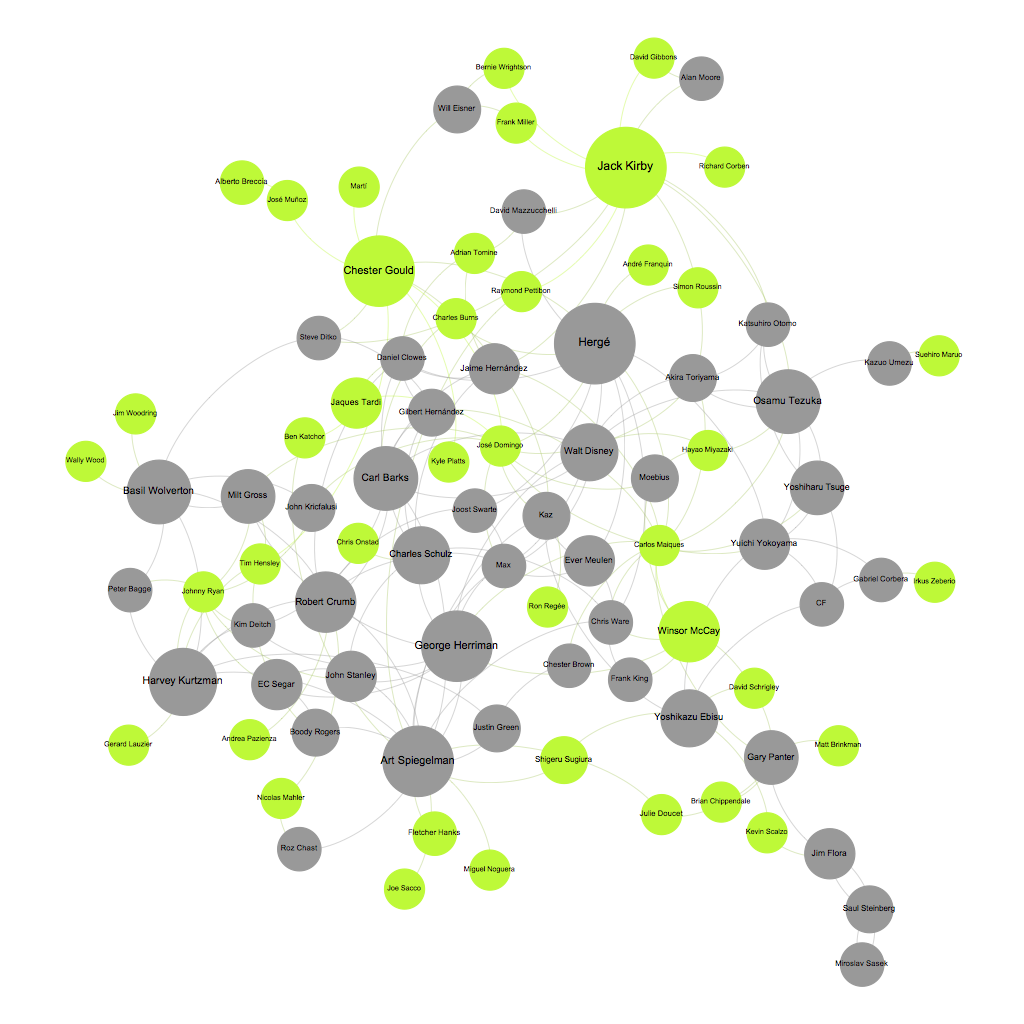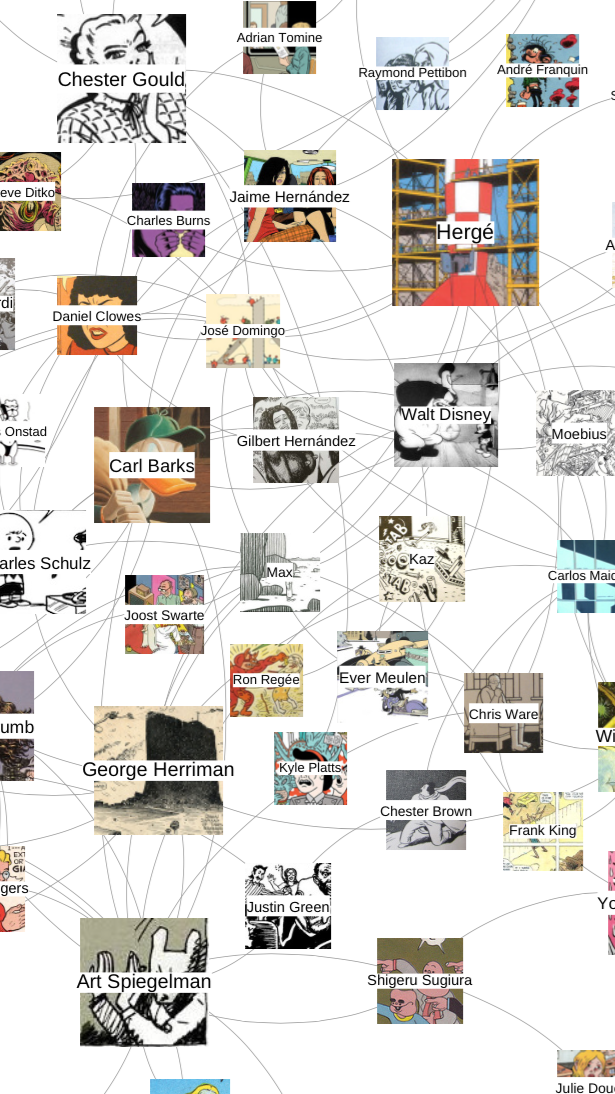Monthly Archives: June 2015
Diagraming the history of comics
I’ve been working with databases and diagramming software applied to comics. The project started with two objectives:
- To visualize a possible history of comics.
- To feed a diagram using a public database in order to avoid a manual design.
Click on the image to see the diagram with all of the node names.
In summary, I started using yEd software, an opensource application with many possibilities but I also wanted to show pictures as nodes. I ended up using Gephi, a complex opensource application that (through this plug in: image preview) uses square images as nodes.
Limiting the Comic History to only 90 authors supposed a disadvantage when I tried to target edges of influence. More than 100 years of comics are a too wide range, even more if you include some artists, illustrators and animators (as I did). The relations I made are quite elastic and the original idea was to ponder the list with other opinions. I should add another 200 artists to work properly but this is a huge task (I just name a few of the future list: Gil Kane, Jim Steranko, Francisco Ibáñez, Vázquez, Taiyo Matsumoto, Sammy Harkham, Dan Nadel, Simon Hanselmann, Sergi Puyol…).
I included from funnies to underground, well established and young experimental alike. American, European and Japanese. I didn’t include some of my favorites (as a teenager reader) but I add some others with little references but a strong personality: Master Ebisu, Milt Gross or Matt Brinkman, for instance. Some of them remain an island (I know that Johnny Ryan was influenced by Frank Frazetta, but I don’t know who considers Richard Corben an ancestor). That probably is true for other artists (the ones that didn’t established themselves as narrators). There are artists like Yokoyama that are not able to name another artist as an influence and others like Max or Spiegelman that could easily name hundreds of them.
Some of them are more interesting as editors or commentators than as real authors. Some authors are quite young and they still have their best works in their imagination.
I think that is a good point to start re imagining the subject.
I talked to some of the new artists included in the list and I realised that this canon is little more than personal: they didn’t knew some of the relations I had envisioned for them… but that’s OK.
Here is the node list (and the file with secondary info):
Winsor McCay, George Herriman, Frank King, Fletcher Hanks, EC Segar, Milt Gross, Chester Gould, Carl Barks, Walt Disney, Boody Rogers, Herge, Shigeru Sugiura, Basil Wolverton, Jim Flora, John Stanley, Saul Steinberg, Miroslav Sasek, Jack Kirby, Will Eisner, Alberto Breccia, Charles Schulz, Andre Franquin, Harvey Kurtzman, Steve Ditko, Wally Wood, Osamu Tezuka, Gerard Lauzier, Kazuo Umezu, Yoshiharu Tsuge, Moebius, Richard Corben, Hayao Miyazaki, Jose Munoz, Robert Crumb, Kim Deitch, Justin Green, Ever Meulen, Jaques Tardi, Joost Swarte, Yoshikazu Ebisu, Art Spiegelman, Bernie Wrightson, David Gibbons, Gary Panter, Ben Katchor, Jim Woodring, Alan Moore, Katsuhiro Otomo, Roz Chast, Akira Toriyama, John Kricfalusi, Andrea Pazienza, Marti, Max, Suehiro Maruo, Frank Miller, Gilbert Hernandez, Peter Bagge, Raymond Pettibon, Jaime Hernandez, Kaz, Chester Brown, David Mazzucchelli, Joe Sacco, Daniel Clowes, Charles Burns, Julie Doucet, Tim Hensley, Chris Ware, Yuichi Yokoyama, David Schrigley, Kevin Scalzo, Nicolas Mahler, Ron Regee, Johnny Ryan, Carlos Maiques, Brian Chippendale, Matt Brinkman, Adrian Tomine, Chris Onstad, CF, Miguel Noguera, Jose Domingo, Simon Roussin, Irkus Zeberio, Kyle Platts and Gabriel Corbera. 

An example of the multiple visualizations based in the influence of a node.
I dreamt of a software that could reorganize the information based in different data (country, born date, out degree and in degree, critical acclaim…). I make public here all of the files. Gephi uses two files as inputs: a node file (I made a csv from a spreadsheet) and an edge file (just the same). After you can use some powerful plug ins in order to organize the size, position and colors of the nodes and edges. The infinite possibilities of algorithmic combination gives you new ideas about the genesis of a style or about the spiritual motivations of authors that initially you thought had nothing in common.
And… I ended the post without saying alternative comics…. ops!



Recent Comments